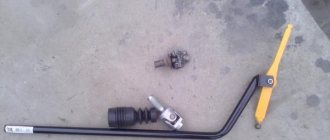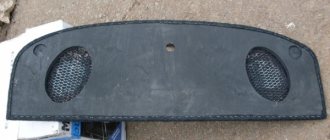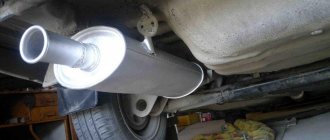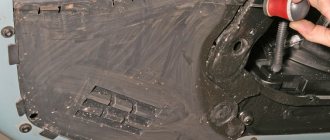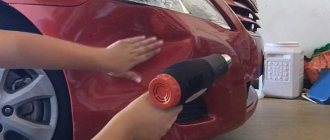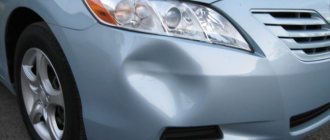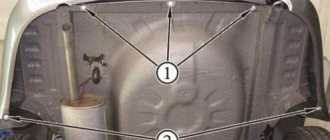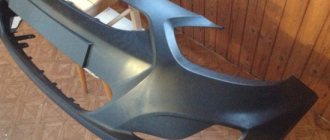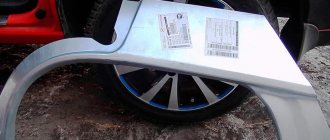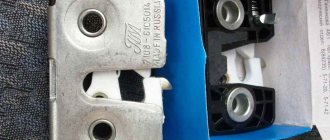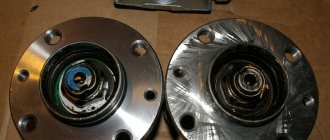The bumper lip is a rubber splitter designed to be mounted on the front bumper, rear bumper or on the door sills of a car. In its initial state, the universal lip looks like a U-shaped strip of dense rubber. When installed, one of the edges of the lip is attached to the bottom of the bumper, as a result of which the lower part of the car looks stylish and acquires a certain completeness.
Comes from motorsport
Another name for this part is splitter. In big motorsport, a splitter is a special limiter in the form of a plane, thanks to which a vacuum is created under the bottom of the car by limiting its flow under the front part of the bumper. The thinner air under the car provides a kind of cushion on which the car acquires greater lightness and, accordingly, speed.
This technology is complex; it is hardly possible to achieve a similar aerodynamic result using a rubber lip at a speed of 90 km/h. However, the universal rubber lip has its own advantages; it makes the operation of the car more comfortable and somewhat special for the car enthusiast.
Types of bumper skirts
According to the Western classification, body kits are divided into 2 main categories: standard and individual (custom). In the first case, the element entirely corresponds to the design of a specific brand or model of car. The second type of style is successfully practiced by professional designers. The part must pass tests for practicality and functionality.
The bumper skirt is made from several materials: carbon, steel, aluminum, silicone. However, the most common is plastic. There are fiberglass spoilers, the installation of which requires qualified intervention due to the complexity of adjusting the gaps and the nuances of using a special glass sealant. They are placed on top of the standard bumper, an additional bolted connection is possible.
There is also an impact-resistant ABS thermoplastic body kit. Its installation is not so complicated, the element is attached with double-sided tape using an adhesion primer, and also with additional bolts in the center, in the invisible part of the bumper.
Popular brands:
Mitsubishi Lancer
Unexpected features
It would seem what changes a 2.5 meter long rubber band can make when using a car. And they exist and, indeed, are very worthy of listing them.
Lip with bumper
- The universal splitter gives the car a new look - more aggressive and sporty. The front of the car seems more predatory due to the fact that it becomes wider due to the lip, and the visual decrease in ground clearance evokes thoughts of a sports car.
- The splitter looks especially organic when combined with other sports body kits. Alternatively, the lip can be attached around the perimeter of the car: above the wheel arches, on the rear bumper and along the side line of the car.
- When operating a car in bad weather, the space under the hood of the car gets dirty much less. In addition, when falling into deep puddles, a significant part of the water is “extinguished” by the lip on the bumper, so much less dirty water gets onto the windshield.
- The universal rubber lip will appeal to those who, when parking, rely on the bumper scraping against the curb. The rubber lip will protect the bumper from chips, scratches, and tears. This universal part costs tens of times less than a bumper, and, if necessary, will take a damaging blow. The lining material rarely tears, never breaks, and quickly returns to shape after deformation.
Features of choice
The part is produced by several manufacturers in China, the USA and Korea. Products differ in the quality of rubber, the width of the tape, and the curvature of the contour along the width. Some manufacturers supply their creations with soldered decor of various colors - so that you can choose a lip to match the car body.
As already mentioned, the finished part is a tape of various lengths. The length of the rubber lip in the standard version is 2.3 meters. This length is quite sufficient for standard sedan cars. If a splitter is purchased for GAZelles, KAMAZs and jeeps, it makes sense to pay attention to tapes with a length of 250, 280, 300 or 330 centimeters. Just keep in mind that the longer the tape, the higher the cost.
In order not to get into trouble with choosing the length of the product, it makes sense to use a tape measure to measure the required length of the part of the car that you plan to refine: bumper, wheel arches, sills, rear bumper. Manufacturers recommend buying a lip 10 centimeters longer than the figure obtained as a result of the measurement.
Tuning a car bumper using building materials
At the very beginning of the work, you need to clearly understand the technique of its implementation.
To make the body kit look unique, you are allowed to tune the front or rear bumper yourself or make changes to the factory model.
For understanding, we will describe both of the above versions.
Initially, it is necessary to remove the body kit from the vehicle for its subsequent cleaning. Do-it-yourself tuning of the rear and front bumpers is no different from each other.
It is necessary to fix thick cardboard on the right and left edges, so that the mounting foam will be concentrated in one place.
When using foam, you need to take into account that when drying, it expands and becomes voluminous. After filling the product with this mounting agent, let the foam dry, and then make the desired shape of the body kit.
To work you will need a knife and sandpaper. The body kit should then be properly treated with fiberglass and epoxy resin. After applying the putty, the layer is re-treated with sandpaper.
The final step will be priming and painting the finished product.
The hardest thing is to make the body kit yourself. Let's take a closer look at the bumper manufacturing process.
Installation: simple but delicate
In the simplest version, installation will involve attaching the apron to the bumper using double-sided tape. However, this method is not the most reliable; there is a risk of losing the apron at high speed or when the car is used harshly.
An alternative option involves attaching the skirt using a construction stapler. This method is more successful. During the work, you must ensure that brackets are placed at least 1 bracket per 10 cm.
The ideal, but also the most labor-intensive installation method involves fixing the product using self-tapping screws and plastic washers. The fastening step is also 10 cm. It will take a little more time, but you definitely won’t have to redo it!
When installing, it is recommended to make cuts along the edge of the tape so that it fits neatly in the bend areas. It is better to make cuts in the shape of the letter A.
The installation is most conveniently carried out on an overpass.
Nowadays, car stores offer a considerable variety of all kinds of spoilers. However, often those that you like in appearance are partially not suitable in size. Or those that fit perfectly fall somewhat short in terms of characteristics.
Fiberglass bumper manufacturing process
To make the product yourself, you will need not only components, but also competent guidance on how to make this tuning element.
What is needed to glue the product
An experienced car enthusiast can find most of the tools in his garage. Then you should check the list below and purchase the missing materials and equipment. You need:
- epoxy resin - 400 ml (if epoxy is not available, you can use polyester resin);
- fiberglass packaging (the best option is “Steklomat 300” and “Steklomat 600”);
- gelcoat hardener (taken at the rate of 1 cube per 200 ml of resin);
- Bulgarian;
- protective gloves, respirator, glasses;
- industrial plasticine - 5 kg;
- masking tape - 5 rolls;
- putty knife;
- rubber roller;
- sandpaper;
- Teflon polish.
Photo gallery: materials for work
Sequence of operations to create a part from scratch
The algorithm below will help you figure out how to properly glue the bumper:
- The standard bumper is removed from the car. Areas that have become unusable are carefully cut off using a grinder (this category usually includes the lower edge and openings of fog lights).
- Strips of masking tape are glued to the areas of the bumper surface that are planned to be changed, then a thin layer of warm industrial plasticine is applied to the tape.
- Next, a second layer of cold plasticine is applied, which is carefully pressed down and leveled with a spatula (a rubber roller can also be used for these purposes).
- Masking tape is again glued onto the upper part of the plasticine-coated bumper (this is what will be used to check the shape of the bumper and check the lines).
- Now a series of parallel lines are applied to the layer of tape with a marker, located at a distance of 10 cm from each other (this is necessary so that the future shape of one side of the bumper can be easily transferred to the other side, and this can be done with maximum accuracy).
- The adhesive tape profile obtained in this way is transferred to the second side of the bumper.
- Then the tape and markings are applied in the same way to the lower edge of the bumper, after which holes for the fog lights are carefully cut in the plasticine.
- The resulting model is installed in the working position, its symmetry and the correct location of the holes are assessed.
- Now, based on the modified bumper, it is necessary to make a matrix, according to which a new bumper will be created. The entire prepared surface is covered with Teflon polish in at least 3 layers (this will not allow the old bumper to stick to the matrix). Then a layer of gelcoat hardener is applied to the polish, which is sometimes mixed with aluminum powder.
- At the next stage, to strengthen the bumper, several layers of epoxy resin are applied to it, on which a layer of fiberglass is laid. In this case, it is necessary to ensure that no air bubbles remain under the fabric.
- Once the fabric has hardened, the surface is sanded to remove any loose fibers.
- The old bumper is carefully removed from the matrix. The plasticine remaining on it must be thoroughly washed off with either kerosene or white spirit.
- The resulting matrix is lubricated from the inside first with industrial wax, then with a gelcoat hardener, after which the first layer of fiberglass is applied. It is rolled with a rubber roller to eliminate bubbles. Next, the second layer is laid, then the third (and for the third layer it is recommended to use “Steklomat 600”).
- The resulting structure must be allowed to harden within 24 hours. After this, the finished fiberglass bumper is carefully removed from the matrix and processed with fine sandpaper. Now it is ready for painting.
What can you make a car spoiler from with your own hands?
If you encounter similar problems, then, of course, there is an option to buy a ready-made spoiler, and if there is not enough length, simply saw the object and make an insert. The time required is minimal, but here the cost of the material and paint is added to the cost of the spoiler itself. And this turns out to be quite expensive.
Creating a spoiler from scratch is profitable (the average cost is about 25-35 dollars) and convenient. In order to make a spoiler yourself according to your taste and necessary requirements, we will need:
- Styrofoam; - epoxy adhesive; - Sheet steel; - fiberglass or old silk-look shirts; - paint of the required color.
Bumper Skirt Installations
To independently install such a body kit, you will need many different tools and related materials. It must match the shape of the bumper as accurately as possible, so you often have to adjust it - trim or extend it, as well as prime and paint it. Even if this is a standard product, it is difficult to find an option that matches the color of the body.
Carry out the installation in three stages: preparation, painting and finishing. Work in summer, when the air temperature is at least 20 degrees Celsius, in non-rainy weather.
In Moscow, installation of the skirt is carried out by automobile installation centers and service studios. The price of the service varies, it all depends on the specific choice, material and other nuances.
Spoiler creation process
Working with polystyrene foam is quite simple, but there is one caveat. After cutting, a lot of debris remains, which is very well electrified and can stick to the drying element at the most crucial moments. Therefore, try to remove the crumbs immediately.
We cut a sheet of foam plastic measuring 1x1 and 4.5 cm thick (sellers usually say 5 cm) diagonally. Cut out the wing blade. So the width of the foam sheet will definitely be enough for you. Next we move on to the fastenings. It is necessary to cut 1.5 mm plates from sheet steel. We drill 3 mm holes with a distance of approximately 2-3 cm. In order to reduce weight and improve adhesion, bend them with the letter L. After these manipulations, weld two 6 mm nuts to the base. Now you can glue them into foam blanks.
We glue the wing blade with epoxy glue and two layers of fabric. Then we assemble the structure.
Working on the lip
The lip is done the same way - not very difficult. Remove the bumper and turn it over. Next, you need to glue the blank from foam plastic. We give it a shape and wrap it in plastic bags. Ideally, it is better to find ordinary nylon women's tights, pull them onto the form and coat them with epoxy glue. When the two layers of tights are dry, you need to pull the blank out of the lip. The bags are needed just so that the blank can come off easily, since the epoxy glue does not stick to them. We leave the structure for several days so that the epoxy completely polymerizes.
What is it for?
Contrary to the fairly widespread belief that the lip on the VAZ 2114 bumper is purely a tribute to fashion or a desire to stand out, it is completely wrong.
Of course, such an element adds individuality to the car and changes its appearance, but at the same time the lip also has a direct functional purpose - it changes the aerodynamics of the car and its behavior on the road (which is why in foreign countries, and often here too, it is directly related to aerodynamic elements such as spoilers).
In addition, they also perform some protective function of the bumper itself.
What material is it made from?
In the vast majority of cases, the material chosen for the front lip is:
- lightweight plastics (including metallized);
- fiberglass;
- rubber;
- carbon fiber reinforced plastics (rarely).
VAZ 2114 lip from an old bumper
At the same time, this element is never made from heavy materials, for obvious reasons.
With your own hands
Of course, going and buying (or ordering) a bumper lip is the simplest solution, but it is quite possible to make such a body kit element yourself - this requires a minimum of tools and basic skills in working with them.
Of course, more advanced craftsmen can make a lip from scratch from sheet plastic, cutting and bending it to size, but now we will look at the simplest, and accessible to absolutely everyone, method - making it from the front bumper. In this case, the lip of the VAZ 2114 is made from a bumper also for the VAZ 2114.
Car bumper skirt - what is it and what is it for?
An addition to the bumper is otherwise, in technical language, called a body kit or trim, lip. Often, to properly secure it, the skills of a body shop are required. Without a correct fit, the lip does not sit correctly, and modernization becomes a waste of money and time.
The skirt is a spoiler with a special arrangement. The element is separate, can be a single piece or a composite spare part. The main thing is that with proper installation, the aerodynamics of the body increases. This effect is explained by the special design of the part, which is capable of redirecting air flows. Therefore, it is also called an aerodynamic fairing.

